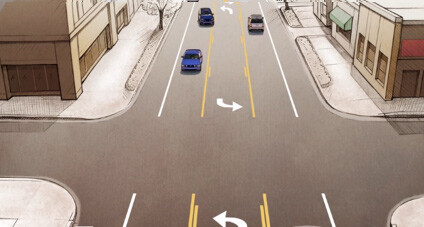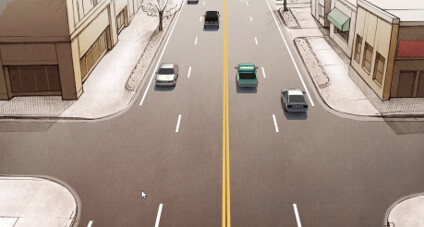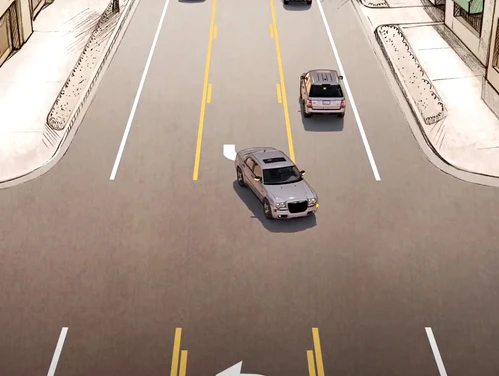On this page...
What Is A 4- To 3-Lane Conversion?
A 4- to 3-lane conversion (a type of road diet) involves restriping a 4-lane road as a 3-lane road. One lane is provided in each direction with a continuous left turn lane down the center. This often leaves room left over which can be used for enhancements such as parking or bike lanes. When combined with a roadway resurfacing project, a 4- to 3-lane conversion can be completed without any additional cost. 4- to 3-lane conversions are one of the Federal Highway Administration’s (FHWA’s) 20 proven safety countermeasures.
What Are the Benefits of a 4- To 3-Lane Conversion?

- Shown to reduce crashes by about half.
- Decreases left-turn and rear-end crashes because of the dedicated center turn lane.
- Opportunity to provide enhancements such as parking or bike lanes.
- Improves walkability - fewer lanes for pedestrians to cross, and traffic is located farther from the sidewalk.
- Easier access to homes, schools, and businesses.
- Regulates speeds and calms traffic. Speeds are more consistent with just one lane in each direction.
When Should a 4- to 3-Lane Conversion Be Considered?

There are many factors that should be considered before implementing a 4- to 3-lane conversion. Some of the factors that the Iowa DOT considers are:
- Traffic volume
- Number of intersections
- Type and location of access points
- The corridor’s crash history
Many communities in Iowa have had success implementing 3-lane roads in urban, suburban, and rural locations.
To proactively identify where future conversions might be considered, the Iowa DOT recently conducted a statewide screening. This effort provided a snapshot of potential locations where a conversion might be successful.
Back to top4-to-3 Lane Resources
- FHWA Proven Safety Countermeasures
- FHWA Road Diet Informational Guide
- Iowa Roadway Cross Section Reconfiguration: Responses to 14 Commonly Asked Questions
- Iowa DOT Statewide Screening for Potential Lane Reconfiguration
- AARP Road Diets A Livability Fact Sheet
- Road Diets: A Proven Safety Countermeasure (Long Version) 2016 – FHWA video
- New Jersey DOT Road Diet video
